The Vegetable Sugar Market is estimated to be valued at USD 2.2 billion in 2025 and is projected to reach USD 3.6 billion by 2035, registering a compound annual growth rate (CAGR) of 4.8% over the forecast period.
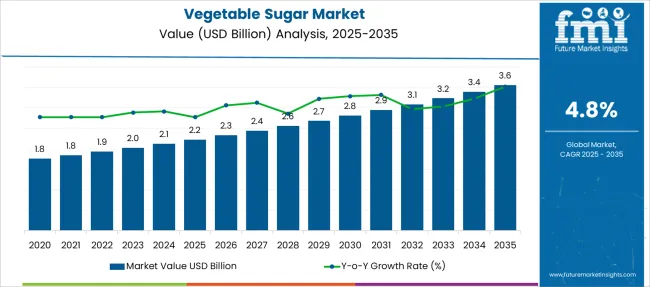
| Metric | Value |
|---|---|
| Vegetable Sugar Market Estimated Value in (2025 E) | USD 2.2 billion |
| Vegetable Sugar Market Forecast Value in (2035 F) | USD 3.6 billion |
| Forecast CAGR (2025 to 2035) | 4.8% |
The vegetable sugar market is gaining traction as manufacturers and consumers shift toward plant-derived, functional sweeteners with improved health profiles. Increased demand for sugar alternatives in processed foods, beverages, and nutraceuticals is influencing product innovation and procurement strategies.
Regulatory focus on sugar reduction, coupled with rising concerns over metabolic disorders, is prompting industries to adopt vegetable-derived sugar sources rich in saccharides and micronutrients. Producers are optimizing extraction techniques to maintain nutritional integrity while scaling production efficiency.
Preference for clean label, non-synthetic ingredients is expected to further drive adoption, especially in segments emphasizing natural origin and calorie-specific formulations. The market is projected to benefit from advances in plant biotechnology, stable supply chains, and sustainability-aligned product development over the forecast period.
The market is segmented by Biomolecules/Nutrients, Application, Availability Of Calories, and Distribution Channel and region. By Biomolecules/Nutrients, the market is divided into Saccharide and Non-Saccharide. In terms of Application, the market is classified into Food Processing Industries, Pharmaceutical, Healthcare, Beverages, Bakery, Frozen Food, and Confectionary. Based on Availability Of Calories, the market is segmented into Natural Caloric Sugar and Natural Zero Caloric Sugar. By Distribution Channel, the market is divided into Online, Super-Mart, Hypermart, and Retailer. Regionally, the market is classified into North America, Latin America, Western Europe, Eastern Europe, Balkan & Baltic Countries, Russia & Belarus, Central Asia, East Asia, South Asia & Pacific, and the Middle East & Africa.
Saccharides are anticipated to lead the vegetable sugar market with a 59.3% revenue share in 2025. Their dominance stems from their fundamental role as naturally occurring carbohydrate structures that deliver sweetness while maintaining metabolic compatibility.
Saccharides derived from vegetables exhibit improved functional properties such as enhanced solubility, binding capacity, and fermentation support. Their prevalence in enzymatic hydrolysis-based extraction processes further contributes to stable quality and scalable yields.
The broad application of saccharide-rich sweeteners across food, beverage, and pharmaceutical formulations reinforces their commercial relevance. Their familiarity among food scientists and favorable consumer perception are supporting increased product incorporation, particularly where refined sugars are being replaced by minimally processed alternatives.
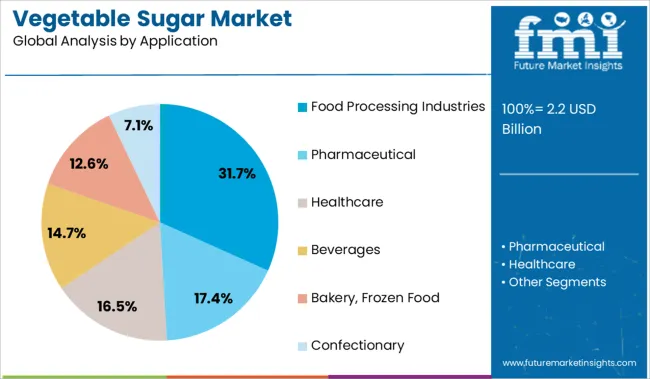
Food processing industries are projected to account for 31.7% of the vegetable sugar market’s revenue in 2025, making this the leading application segment. This position is supported by a growing demand for plant-based, functional sweetening agents that meet formulation needs for taste, shelf stability, and nutritional enhancement.
Vegetable sugars are increasingly being used in processed foods ranging from baked goods and sauces to dairy alternatives and ready-to-eat meals. Manufacturers are responding to clean label initiatives and sugar reformulation targets by incorporating vegetable-derived sugar sources that provide both sweetness and trace bioactive compounds.
The segment is also benefiting from investment in specialty food processing technologies that preserve nutrient value while optimizing texture and flavor delivery.
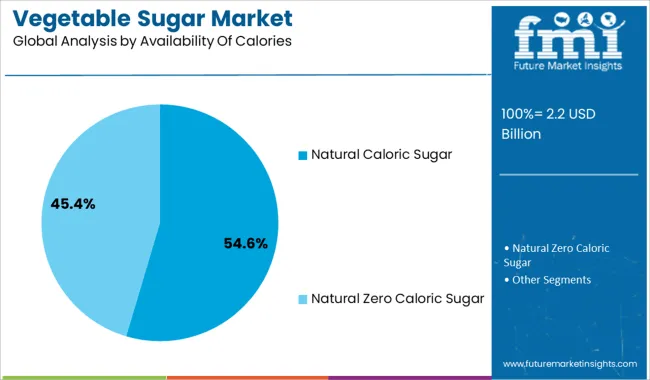
Natural caloric sugar is expected to capture 54.6% of the total market revenue in 2025, positioning it as the dominant segment by calorie availability. This segment’s lead is attributed to the continued demand for sugars that provide energy while being perceived as less processed than synthetic or high-intensity sweeteners.
Vegetable-based natural sugars appeal to consumers seeking familiar taste profiles with transparent sourcing. The segment is being further strengthened by increased production of caloric sweeteners derived from sweet potatoes, beets, carrots, and other vegetables that offer a balance between sweetness and nutritional value.
In contrast to artificial or zero-calorie options, natural caloric sugars maintain a functional role in food structure, mouthfeel, and preservation. This combination of performance and perceived wholesomeness is contributing to their sustained adoption across mainstream and health-focused product categories.
The historical outlook and projections of the market for the world in 2020 were USD 1,518.8 Million During the projection period, it is anticipated that the global market for Vegetable Sugar Market will expand at a CAGR of 4.8% (2025 to 2035).
The worlds vegetable sugar market is booming. The historical outlook for the market was optimistic, and projections for the future are even more so. The demand for sugar is increasing at a rapid pace, as price.
The main drivers of this growth are the rising population and incomes, which are resulting in increased consumption. In addition, changes in dietary habits and trends are also playing a role. For instance, the popularity of healthy eating and plant-based diets is fueling the demand for sugar alternatives.
Supply is also expected to increase in the coming years, as more countries invest in production capacity. Brazil, India, and China are leading the way in this regard. However, it is worth noting that weather conditions can have a significant impact on supply levels.
The Vegetable Sugar Market is a new and upcoming product in the food processing industry. This sugar helps to preserve food taste by maintaining its nutrients and balance. The naturally extracted vegetable sugar is derived from plant stems and fruits, which makes it a natural and safe alternative to synthetic chemicals. There are many benefits to using this agent, including its ability to improve the quality of food and increase shelf life.
Customers believe that natural substances are better for their overall health than synthetic ones, which can have certain negative consequences. As a result, food producers have swiftly reacted to the problem by entirely or partially substituting synthetic substances with their natural equivalents.
The segmented vegetable sugar is divided into two categories: saccharide vegetable sugar and non-saccharide vegetable sugar. The availability of proteins, dihydro halo acene, terpenoids, steroidal saponins, and dihydro coumarin further classify non-saccharides as sweet proteins.
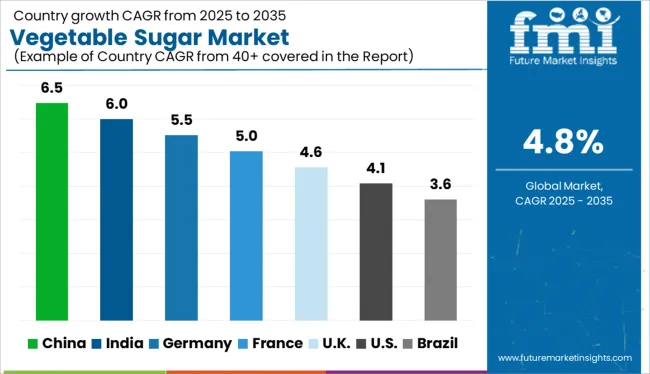
Due to its greater daily sugar consumption, America has the highest market demand for natural vegetable sugar in the region. Although Asia Pacific is the most lucrative region and market for natural vegetable sweeteners, it can be claimed that the sector is still in its infancy. The market for natural vegetable sugar will soon be flooded with opportunities due to the burgeoning global market trends.
On the basis of geography, Vegetable Sugar Market is segmented into seven different regions namely North America, Latin America, Eastern Europe, Western Europe, Asia-Pacific region, Japan, and the Middle East and Africa. North America, Latin America, Eastern Europe, Western Europe, the Asia-Pacific region, Japan, the Middle East, and Africa make up the largest market for Vegetable Sugar.
The Asia-Pacific market scenario is very fragmented, and there are a lot of small and medium-sized businesses there.
The Asia Pacific region's market demand for plant-derived sugar is being driven by emerging markets' increasing need for natural products in personal care, pharmaceutical, food, and beverage, among other industries. Additionally, it is anticipated that the market for plant-derived chelating agents in the region will expand significantly in growing economies like China, India, and Indonesia.
The global market for Vegetable Sugar Market is anticipated to expand at a CAGR of 4.8% from 2025 to 2035, according to a recent FMI analysis. The desire for natural components in vegetable sugar aids in healthcare and personal care industries and also boost to propelling the growth in the industrial market.
The growing demand for natural sweeteners and the increasing preference for plant-based ingredients are the major factors driving the growth of this market.
Supermarkets and industrial distributors are playing a significant role in the growth of the vegetable sugar market. They are constantly striving to meet the rising demand for natural sweeteners by sourcing products from reliable suppliers. Moreover, they are also investing in Research and Development activities to develop new and innovative products.
The increasing preference for plant-based ingredients is another major factor driving the growth of the vegetable sugar market. Consumers are becoming more health-conscious and are looking for alternatives to traditional sugar that are not only healthy but also have a lower environmental impact.
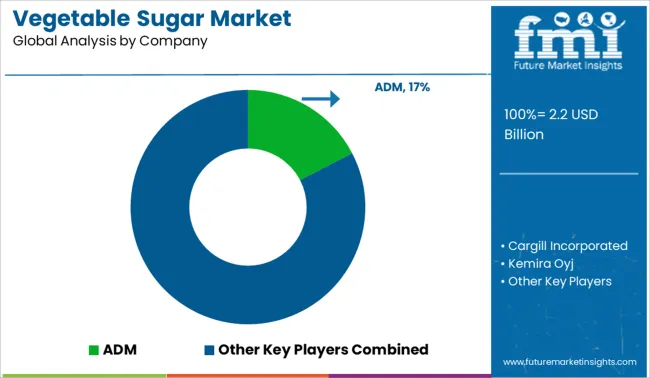
There are many companies striving for market share in the fiercely competitive vegetable sugar business. Cargill, Tate Lyle, and Archer Daniels Midland are the top three competitors in the industry. The market for vegetable sugar is very competitive, with each business vying for an advantage over its rivals. The two biggest competitors on the market, Cargill and Tate Lyle, have been at war for many years. To create new and better products, both businesses have made significant investments in research and development.
DRIVERS: Due to its lack of adverse effects, natural vegetable sugar is currently edging out artificial sweeteners in market share. The market for natural sugar is anticipated to develop at a CAGR of 4.8%.
| Attribute | Details |
|---|---|
| Forecast Period | 2025 to 2035 |
| Historical Data Available for | 2020 to 2025 |
| Market Analysis | USD Million for Value and Units for Volume |
| Key Regions Covered | North America; Latin America; Europe; Asia Pacific; Oceania; Middle East and Africa(MEA) |
| Key Countries Covered | USA, Canada, Mexico, Germany, United Kingdom, France, Italy, Spain, China, Japan, India, South Korea, Australia, Brazil, Argentina, South Africa, United Arab Emirates(UAE) |
| Key Segments Covered | By Form, By Application, By Distribution Channel, By Region |
| Key Companies Profiled | ADM, Cargill Incorporated; Kemira Oyj; The Dow Chemical Company; Nippon Shokub; BASF SE; Akzo Nobel NV |
| Report Coverage | Market Forecast, Company Share Analysis, Competitive Landscape, Drivers, Restraints, Opportunities, and Threats Analysis, Market Dynamics and Challenges, and Strategic Growth Initiatives |
| Customization Pricing | Available upon Request |
The global vegetable sugar market is estimated to be valued at USD 2.2 billion in 2025.
The market size for the vegetable sugar market is projected to reach USD 3.6 billion by 2035.
The vegetable sugar market is expected to grow at a 4.8% CAGR between 2025 and 2035.
The key product types in vegetable sugar market are saccharide and non-saccharide.
In terms of application, food processing industries segment to command 31.7% share in the vegetable sugar market in 2025.






Full Research Suite comprises of:
Market outlook & trends analysis
Interviews & case studies
Strategic recommendations
Vendor profiles & capabilities analysis
5-year forecasts
8 regions and 60+ country-level data splits
Market segment data splits
12 months of continuous data updates
DELIVERED AS:
PDF EXCEL ONLINE
Vegetable Glycerin Market Size and Share Forecast Outlook 2025 to 2035
Vegetable Seed Market Size and Share Forecast Outlook 2025 to 2035
Vegetable Parchment Paper Market Size, Share & Forecast 2025 to 2035
Vegetable Shortening Market Trends and Forecast 2025 to 2035
Vegetable Dicing Machines Market Growth – Food Processing Efficiency 2025 to 2035
Vegetable Carbon Market Trends - Functional Uses & Industry Demand 2025 to 2035
Vegetable Powders Market Insights - Growth & Functional Benefits 2025 to 2035
Vegetable Concentrates Market Growth - Nutrient-Dense Foods & Industry Demand 2025 to 2035
Vegetable Sorting Machine Market Analysis by Processing Capacity, Technology, Operation Type, Vegetable Type, and Region Through 2035
Vegetable Waste Products Market
IQF Vegetables Market Size and Share Forecast Outlook 2025 to 2035
Fresh Vegetables Market Size and Share Forecast Outlook 2025 to 2035
Frozen Vegetable Market Analysis - Size, Share, and Forecast Outlook 2025 to 2035
Brined Vegetable Market Analysis by Nature, Type, End-use, Distribution Channel and Region through 2035
Savory Vegetable Flavours Market Insights - Applications & Industry Growth 2025 to 2035
Canned Vegetable Market Growth – Preservation & Industry Demand 2024-2034
Textured Vegetable Protein Market Size and Share Forecast Outlook 2025 to 2035
Upcycled Vegetable Snacks Market Size and Share Forecast Outlook 2025 to 2035
Fruit And Vegetable Juice Market Size and Share Forecast Outlook 2025 to 2035
Fruit and Vegetable Ingredient Market Size and Share Forecast Outlook 2025 to 2035

Thank you!
You will receive an email from our Business Development Manager. Please be sure to check your SPAM/JUNK folder too.
Chat With
MaRIA